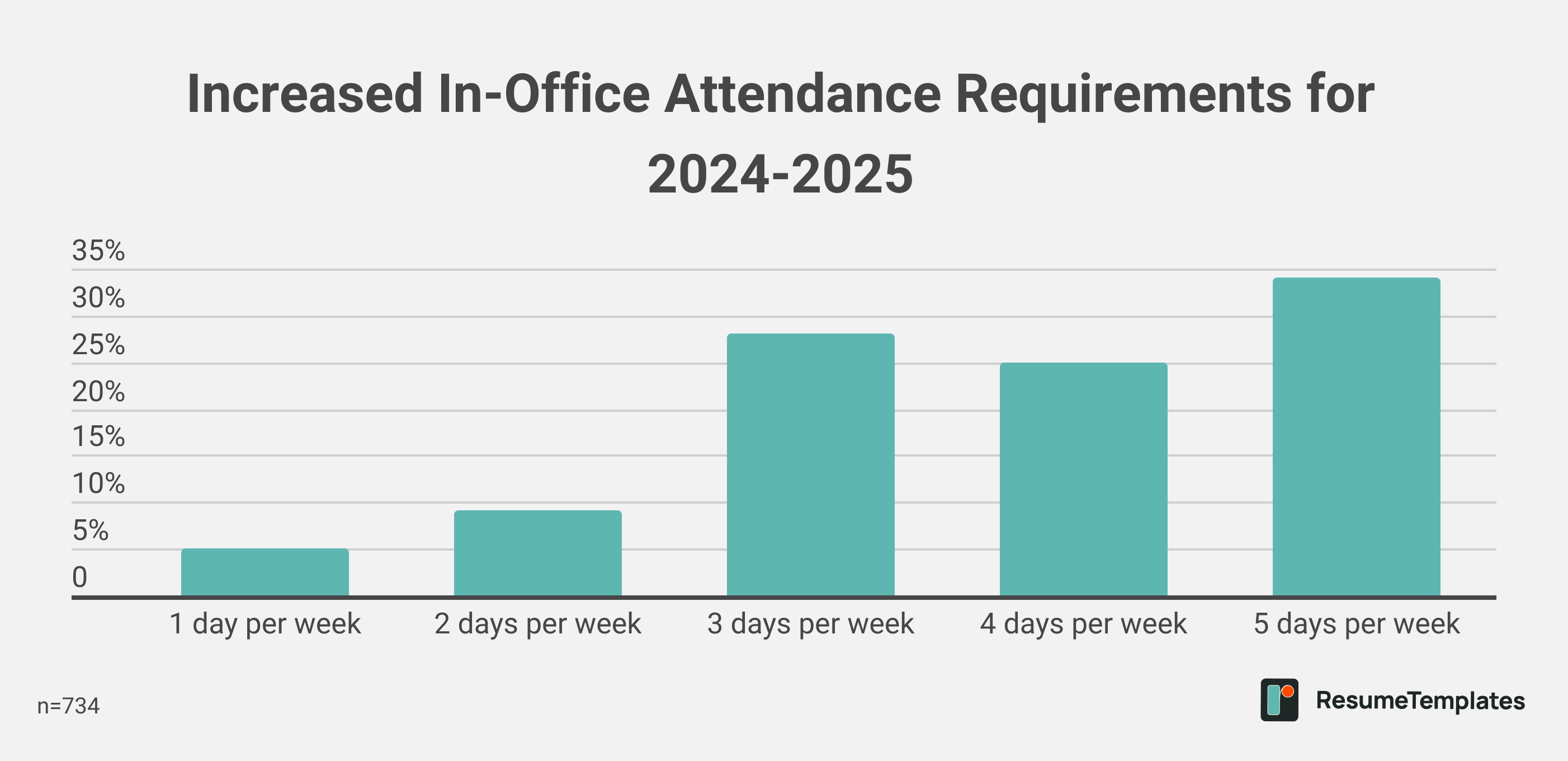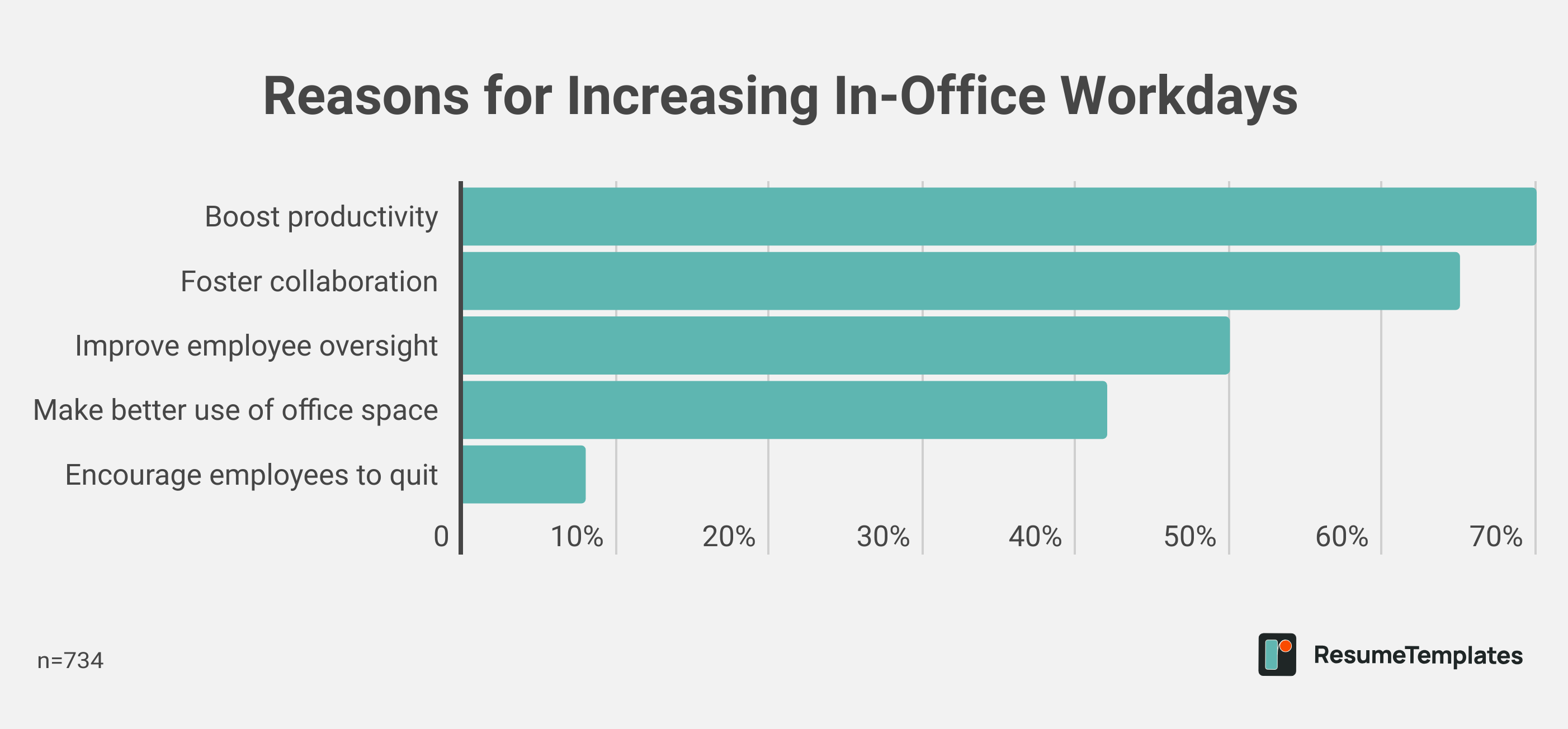Hours after Amazon CEO Andy Jassy announced that employees will be required to return to the office five days a week starting in January, disgruntled employees began to discuss quitting on social media, with some speculating that the new policy is intended to push workers to leave.
ResumeTemplates surveyed 1,551 U.S. business leaders in September about their company’s return-to-office (RTO) strategy for 2024 and 2025 to uncover the motivations behind increasing in-office days.
Study highlights:
- 26% of companies have increased RTO days in 2024, 12% plan to by the end of the year, and 9% will increase them by 2025
- Of these companies, 1 in 3 will require employees to be in-office 5 days per week
- 1 in 10 companies are increasing RTO days to drive employees to quit, with half citing it as a strategy to avoid layoffs
- 6 in 10 companies know increasing in-office days goes against employee preferences
Half of Companies Have Increased RTO Days in 2024 or Will by 2025
More than one-quarter (26%) of companies have already expanded their RTO requirements this year, and an additional 12% expect to make this change by the end of 2024. Looking ahead, another 9% of businesses will follow suit in 2025.
“There are many factors behind why a company might increase RTO,” says ResumeTemplate’s Chief Career Strategist Julia Toothacre. “One of the main ones, which most companies are reluctant to admit, but did reveal in this poll, is the hope that employees will quit, allowing them to avoid layoffs. Additionally, many companies own buildings or have long-term lease contracts and want to make use of the space. Finally, some companies simply don’t trust their employees, or after experiencing a few employees taking advantage of work-from-home, assume all employees are doing the same.”
1 in 3 will require employees in-office 5-days per week
Of the companies that have increased RTO days or plan to by 2025, 34% have increased or will increase the in-office attendance requirement to five days per week. Additionally, 25% are shifting to four days, 28% to three days, and 14% to one or two days per week.

A majority of companies — six in 10 — admit they are ignoring employee preferences for hybrid or remote work. The push for more in-office days is primarily driven by C-suite executives (51%), followed by senior management (41%), and human resources (7%).
“Executives and senior management want more control, especially those that support these mandates. They believe they can manage a person’s work more effectively in person. Physically seeing if the person is working helps them justify the position and the employee. Leaders also want visibility because they feel they need to justify their own salaries. Does this apply to every senior leader? No, some are amazing and pay attention to their people, but those who enforce policies, knowing their people don’t want them, are looking for a power grab,” says Toothacre.
Some Companies Hope RTO Push Drives Employees To Quit
The primary reasons for increasing in-office work days are to boost productivity (70%) and foster collaboration (65%). However, other motivations include improving employee oversight (50%), making better use of office space (42%), and pushing employees to quit (8%).

“Increasing RTO won’t increase productivity. Employees who have to commute are likely to arrive at the office tired and frustrated from the drive, taking longer to settle into their day. Not only that, but some employees will need to arrange care for pets and/or family members, increasing both pressure and costs. Productivity depends on clear expectations and communication, not time in the office — unless the position requires it. This strategy will definitely get people to quit, but not necessarily the right people. Are leaders willing to lose their most productive and top talent just to get everyone back in the office? It’s a risky strategy that may backfire for companies,” says Toothacre.
Half say this will help them avoid layoffs
The main reasons companies want certain employees to quit are to get rid of employees who lack dedication to the company (54%) and poor performers (48%). Further, companies believe this strategy will aid them in reducing costs (48%), avoiding layoffs (48%), and removing lazy employees (43%).

1 in 3 will reduce in-office requirements once enough employees leave
Once a sufficient number of employees quit, 36% of companies plan to reduce office attendance requirements again, while 31% do not, and 33% are undecided.
This survey was conducted in September 2024 via Pollfish. It surveyed 1,551 U.S. business leaders in total. Appropriate respondents were found through demographic criteria.
To take the survey, respondents had to be over 25 years old, have a household income of at least $75,000, at least an undergraduate degree, and currently work at a company with more than 10 employees. Respondents also had to be in a manager-level position or higher.
Resume Templates offers free, HR approved resume templates to help you create a professional resume in minutes. Choose from several template options and even pre-populate a resume from your profile.